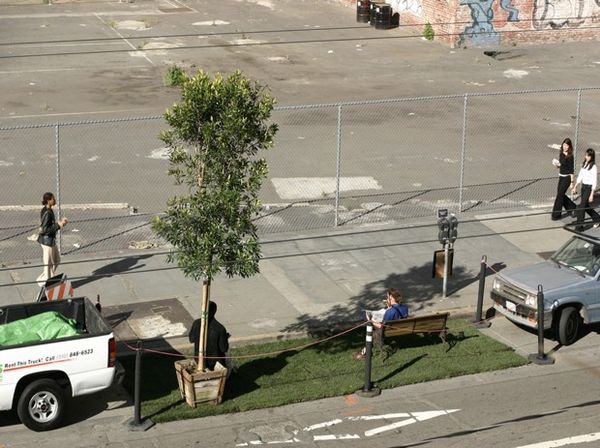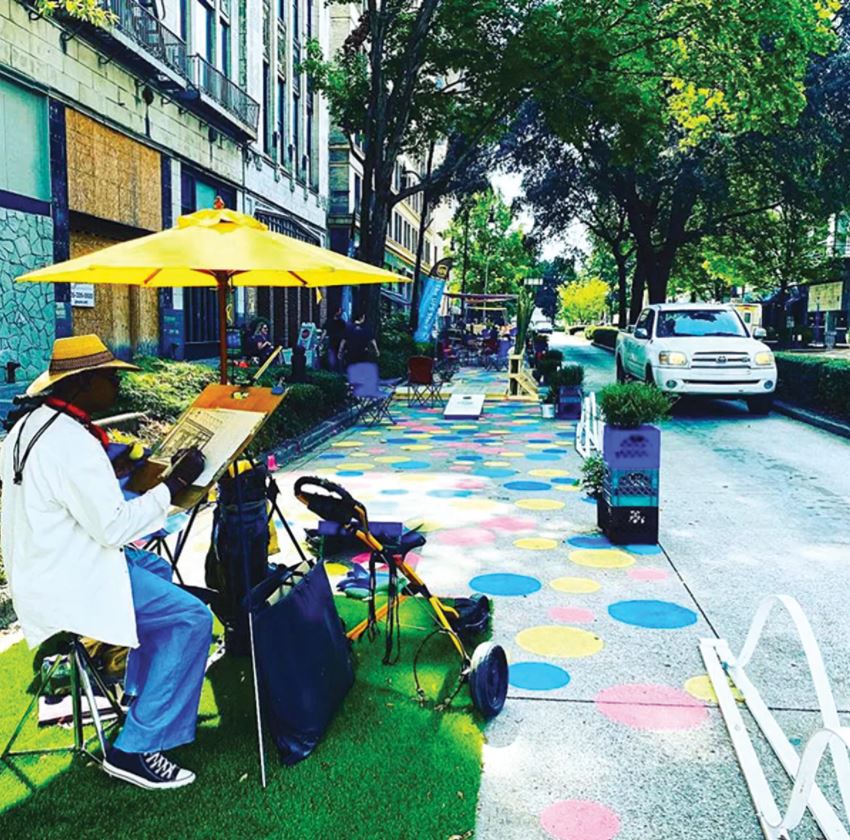By Jonathan Crain
It all started in 2005 when three urban designers went looking for “unscripted fragments” of space in San Francisco that could be used in a fun and engaging way.
Noticing that pay-by-the hour street parking was actually remarkably cheap real estate, John Bela, Blaine Merker, and Matthew Passmore hatched a plan to turn a single parking spot into a mini-park for one day, greening up a particularly gray stretch of San Francisco streetscape. To pull it off, they would need some turf, one tree, a bench, and enough pocket change to keep the meter fed.

The objective was to create a more people-centric street. Once pictures of people enjoying this unusual project hit the internet, the group started getting requests and questions from people all over the world about how they could make use of small unprogrammed spaces in their own cities.
Rather than try to own the event, the group adopted an open-source strategy by creating a guide and giving everyone the knowledge and tools to launch their own Park(ing) Day. Now the event has become a tradition: The third Friday in September is a celebration of people-focused public spaces and creative problem solving around them!
In Birmingham, our local chapter of the American Society of Landscape Architects has taken up the Park(ing) Day charge. Last year saw Park(ing) Day migrate from Homewood into downtown Birmingham with a creative activation of 20th Street North.
20th Street has historically been downtown’s “main street” and 2019’s Park(ing) Day was the first step toward creating a more vibrant main street for Birmingham. Auburn Urban Design Studio students designed and fabricated wooden structures that brought the parking/loading space up to sidewalk level and added shade, seating, and handicapped accessibility to the street. The pedestrian space of the sidewalk was extended using some light flexible barriers made from PVC and denoted with a design made of chalk-painted circles to create visual interest and make pedestrians feel more welcome.

The demonstration also added programming such as animals from The Birmingham Zoo and games like giant Jenga (provided by AARP) to entice people to enjoy this new pedestrian plaza.
The 20th Street Park(ing) Day project was overwhelmingly well received with positive feedback from passersby, and plenty Birminghamians stopping by to relax and enjoy the space.
You may have noticed that the third Friday in September 2020 is right around the corner… Stay tuned for an even more ambitious vision for what 20th Street could become!
Related News
-
Safeguarding history, one preservation easement at a time
Filed Under: Developer, Front Page, Historic Preservation, Yaysayers
As longtime preservation advocates, we’re also proud to introduce REV’s own Historic Preservation Easement Program, created to help safeguard Birmingham’s irreplaceable architecture while adding long-term value to development projects involving historic properties.
-
Preservation that pays: How historic tax credits can power a downtown revival
Filed Under: Developer, Downtown Birmingham, Front Page, Historic Preservation
For preservation advocates (or “building huggers,” as we like to call ourselves), historic tax credits are essential. They don’t just help save historic buildings — they support local economies, encourage private investment and breathe new life into spaces that shape the identity of our communities.
-
Date night done right: Romantic outings you’ll fall for in Birmingham
Filed Under: Birmingham Food & Drink, Downtown Birmingham, Family Friendly, Front Page, Residential, Yaysayers
Looking for the perfect way to spend quality time with your special someone? In this guide, we’ve rounded up a variety of Magic City date ideas tailored to different tastes, personalities and interests. So, grab your partner, or even a few friends, and explore some of Birmingham’s best spots for a truly memorable time.